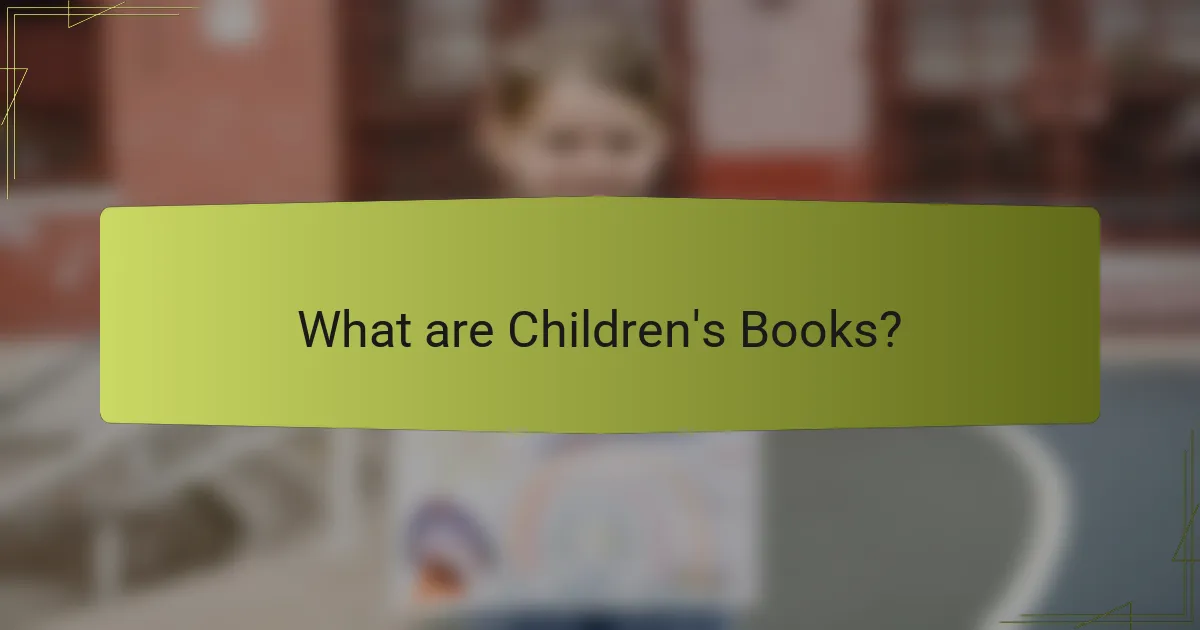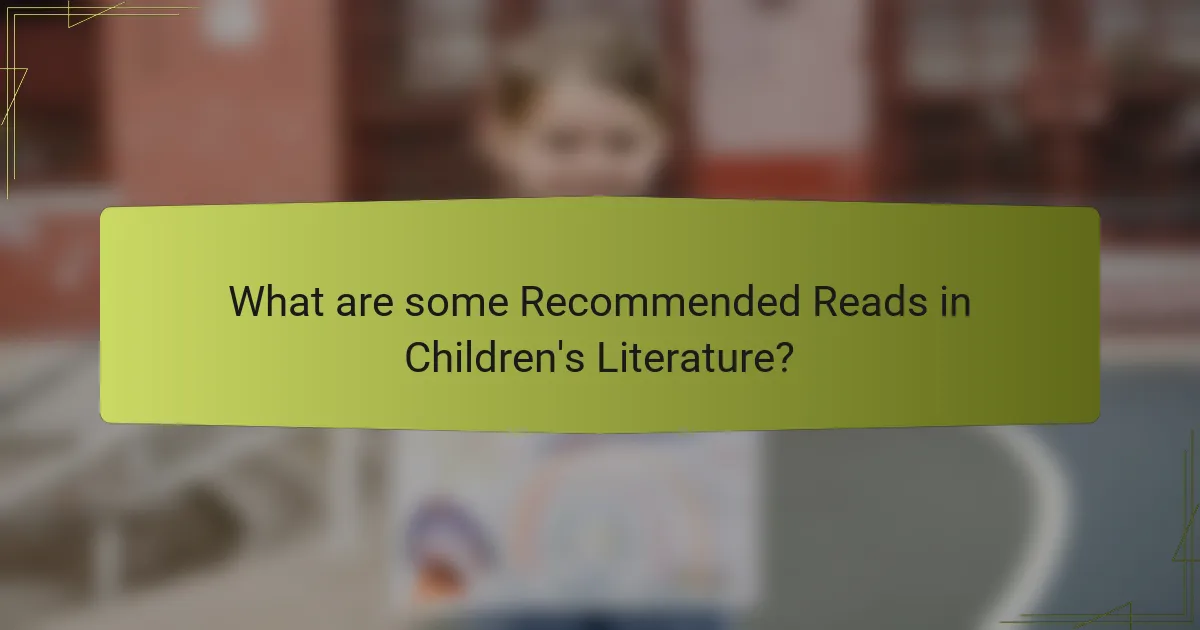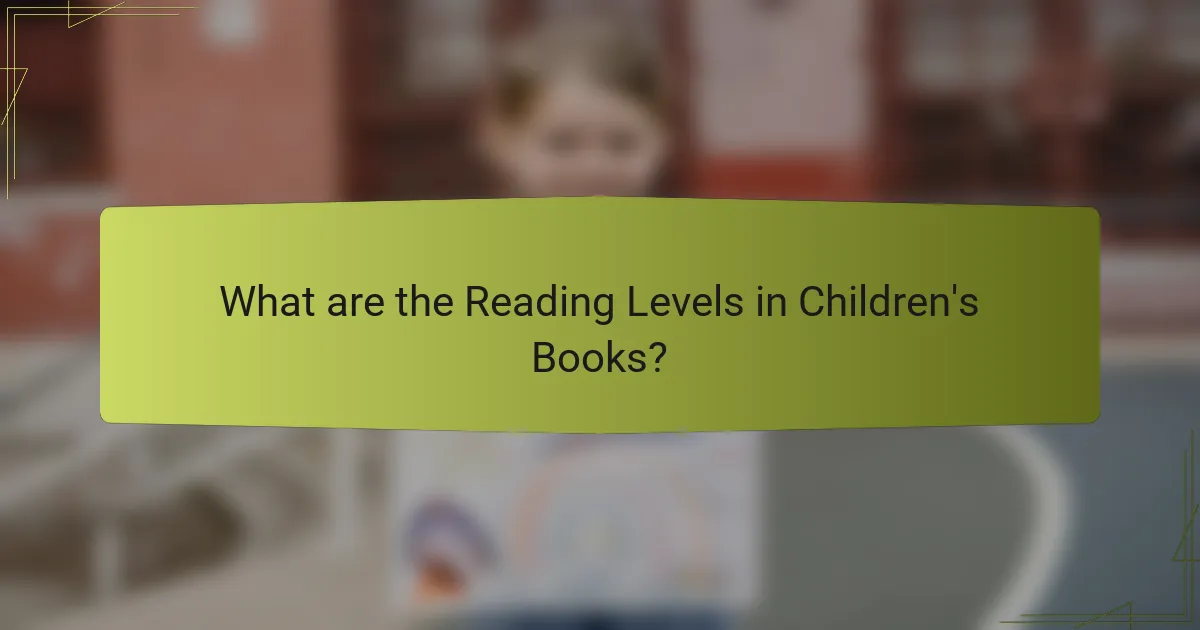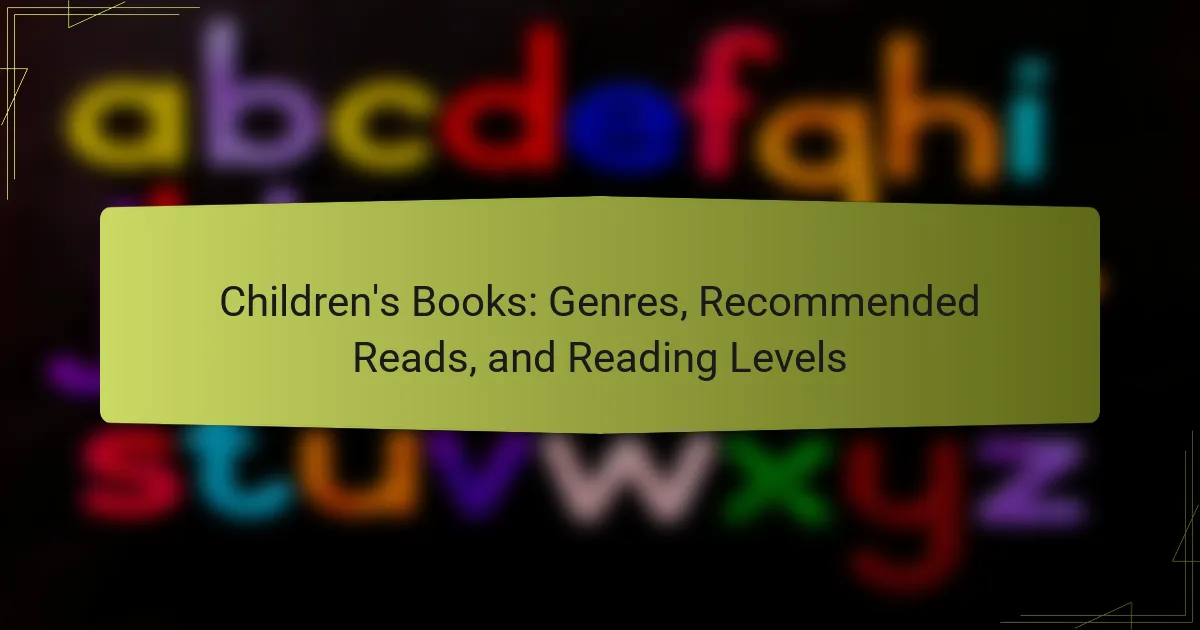Children’s books are written works tailored for a young audience, encompassing genres such as picture books, early readers, and chapter books. These texts often include illustrations and utilize simple, age-appropriate language to educate and entertain while inspiring imagination. The article highlights the importance of children’s literature in developing literacy and fostering a love for reading, featuring recommended titles like “Where the Wild Things Are” and “Harry Potter and the Sorcerer’s Stone.” Additionally, it discusses reading levels, which categorize books based on complexity to assist educators and parents in selecting appropriate materials for children, ultimately enhancing reading skills and comprehension.

What are Children’s Books?
Children’s books are written works specifically designed for a young audience. They encompass various genres, including picture books, early readers, and chapter books. These books often feature illustrations to engage children visually. The language used is typically simple and age-appropriate.
Children’s books aim to educate, entertain, and inspire imagination. They often convey moral lessons or themes relevant to childhood experiences. The content is tailored to different reading levels to accommodate varying ages and skills. According to the Association for Library Service to Children, children’s literature plays a crucial role in developing literacy and fostering a love for reading.
How do Children’s Books differ from other genres?
Children’s books differ from other genres primarily in their target audience and content complexity. They are specifically designed for children, focusing on themes and vocabulary suitable for younger readers. The language used is often simpler, with shorter sentences and familiar words. Illustrations play a significant role in children’s books, enhancing understanding and engagement. These books typically convey moral lessons or values, making them educational as well as entertaining. The narrative structure is often straightforward, with clear beginnings, middles, and ends. Additionally, children’s books often address developmental milestones, catering to various age groups. This focus on age-appropriate content distinguishes them from [censured] genres, which may explore more complex themes and language.
What are the key characteristics of Children’s Books?
Children’s books are designed specifically for young readers. They often feature simple language and engaging illustrations. These books typically have relatable characters and themes appropriate for children. They encourage imagination and creativity through storytelling. The content is usually age-appropriate, addressing topics relevant to children’s experiences. Many children’s books include moral lessons or educational elements. The length of these books varies, but they are generally shorter than [censured] literature. They often use repetitive phrases to aid in language development.
Why is it important to categorize Children’s Books?
Categorizing children’s books is important for effective selection and accessibility. It helps parents, educators, and librarians find appropriate materials for specific age groups and reading levels. Organized categories enhance the learning experience by matching content with developmental stages. Research shows that children engage more with books tailored to their interests and comprehension abilities. For instance, a study by the American Library Association indicates that children are more likely to read regularly when books are easily categorized. This system also aids in promoting diverse genres, ensuring children are exposed to various themes and perspectives. Overall, categorization fosters a more enriching reading environment for young readers.
What are the main genres of Children’s Books?
The main genres of children’s books include picture books, early readers, chapter books, middle-grade fiction, and young [censured] fiction. Picture books are designed for preschoolers and combine illustrations with simple text. Early readers bridge the gap between picture books and chapter books, featuring more text and fewer illustrations. Chapter books target children who are ready for longer stories with more complex plots. Middle-grade fiction appeals to readers aged 8 to 12, often exploring themes of friendship, adventure, and identity. Young [censured] fiction addresses more mature topics and is aimed at teenagers. Each genre serves distinct developmental needs and interests of children at various ages.
How do Fiction and Non-Fiction genres differ in Children’s Books?
Fiction and non-fiction genres in children’s books differ primarily in their content and purpose. Fiction includes stories created from the imagination, featuring characters and events that are not real. Non-fiction, on the other hand, presents factual information about real people, events, and concepts.
Fiction aims to entertain and engage young readers through imaginative narratives. Popular examples include fairy tales and adventure stories. Non-fiction educates children by providing accurate information, often using illustrations to enhance understanding.
The American Library Association states that fiction can stimulate creativity, while non-fiction can develop critical thinking skills. Both genres play essential roles in a child’s literacy development.
What are the popular sub-genres within Children’s Fiction?
Popular sub-genres within Children’s Fiction include adventure, fantasy, mystery, and historical fiction. Adventure stories often feature young protagonists embarking on thrilling quests. Fantasy sub-genres introduce magical elements and fantastical creatures. Mystery stories engage readers with puzzles and clues to solve. Historical fiction immerses children in different time periods and events. Other notable sub-genres are science fiction, which explores futuristic themes, and realistic fiction that reflects everyday life. Each sub-genre serves to captivate young readers and enhance their literary experience.
How does Poetry fit into the Children’s Books genre?
Poetry fits into the Children’s Books genre as a unique form of literature that engages young readers. It uses rhythm, rhyme, and imagery to capture children’s attention. Poetry often conveys emotions and ideas in a concise manner. This makes it accessible for early readers. Many children’s poetry books include illustrations that enhance understanding. Notable examples include “Where the Sidewalk Ends” by Shel Silverstein. These books often promote language development and creativity. Poetry also encourages children to express their feelings and thoughts. Overall, it plays a significant role in nurturing a love for reading.

What are some Recommended Reads in Children’s Literature?
Recommended reads in children’s literature include “Where the Wild Things Are” by Maurice Sendak and “Charlotte’s Web” by E.B. White. These books are celebrated for their imaginative storytelling and emotional depth. “The Very Hungry Caterpillar” by Eric Carle is a classic for younger readers, teaching counting and days of the week. “Harry Potter and the Sorcerer’s Stone” by J.K. Rowling has captivated children with its magical world and themes of friendship. “Matilda” by Roald Dahl showcases the power of intelligence and resilience. Each of these titles has received critical acclaim and remains popular among children and educators alike.
What are the top recommended Children’s Books for different age groups?
Top recommended children’s books vary by age group. For infants to toddlers (0-2 years), “Goodnight Moon” by Margaret Wise Brown is a classic. “The Very Hungry Caterpillar” by Eric Carle is also highly regarded. For preschoolers (3-5 years), “Where the Wild Things Are” by Maurice Sendak is a favorite. “Chicka Chicka Boom Boom” by Bill Martin Jr. and John Archambault is popular too. For early elementary (6-8 years), “Charlotte’s Web” by E.B. White is often recommended. “The Magic Tree House” series by Mary Pope Osborne is well-liked as well. For middle grade readers (9-12 years), “Harry Potter and the Sorcerer’s Stone” by J.K. Rowling is a top choice. “Percy Jackson & The Olympians: The Lightning Thief” by Rick Riordan is another favorite. These selections reflect the preferences and developmental stages of children in each age group.
What are the best picture books for toddlers?
The best picture books for toddlers include “Brown Bear, Brown Bear, What Do You See?” by Bill Martin Jr. and Eric Carle. This book features repetitive text and colorful illustrations that engage young readers. “The Very Hungry Caterpillar” by Eric Carle is another favorite, teaching counting and the days of the week through a simple story. “Goodnight Moon” by Margaret Wise Brown is a classic bedtime story that introduces toddlers to a soothing routine. “Where’s Spot?” by Eric Hill uses flaps for interactive reading, enhancing engagement. “Chicka Chicka Boom Boom” by Bill Martin Jr. and John Archambault introduces the alphabet in a fun, rhythmic way. These books are widely recommended for their educational value and entertainment for toddlers.
Which chapter books are highly recommended for early readers?
“Early readers are highly recommended to explore chapter books such as ‘Magic Tree House’ series by Mary Pope Osborne. This series offers engaging stories for young readers. Another excellent choice is the ‘Junie B. Jones’ series by Barbara Park. These books feature relatable characters and humorous plots. ‘Flat Stanley’ by Jeff Brown is also a popular option. It encourages creativity and imagination. Each of these series is designed to build reading confidence. They use simple language and engaging illustrations. These characteristics make them suitable for early readers.”
What are the must-read middle-grade novels?
Must-read middle-grade novels include “Harry Potter and the Sorcerer’s Stone” by J.K. Rowling. This book introduces readers to a magical world and important themes of friendship and bravery. Another notable title is “Wonder” by R.J. Palacio, which promotes kindness and acceptance through the story of a boy with [censured] differences. “The Giver” by Lois Lowry is essential for its exploration of memory and individuality in a dystopian society. “Percy Jackson & The Olympians: The Lightning Thief” by Rick Riordan combines adventure and Greek mythology, appealing to young readers. “The Chronicles of Narnia: The Lion, the Witch and the Wardrobe” by C.S. Lewis is a classic that captivates with its rich fantasy elements. These novels are frequently recommended for their engaging narratives and valuable life lessons.
How can parents and educators choose the right books for children?
Parents and educators can choose the right books for children by considering the child’s age, interests, and reading level. Selecting age-appropriate books ensures the content is relatable and understandable. Matching books to a child’s interests fosters engagement and a love for reading. Evaluating reading levels helps in providing appropriate challenges without causing frustration. Resources like the Lexile Framework can assist in identifying suitable reading levels. Consulting book lists from reputable sources can provide recommendations tailored to specific age groups and interests. Engaging children in discussions about their preferences can guide selections effectively.
What criteria should be considered when selecting Children’s Books?
When selecting children’s books, consider age appropriateness, content quality, and themes. Age appropriateness ensures the book matches the child’s reading level and comprehension. Content quality involves engaging storytelling, relatable characters, and well-crafted language. Themes should resonate with children’s experiences and foster moral or emotional growth. Additionally, illustrations play a crucial role in attracting young readers and enhancing understanding. Diversity in characters and stories can promote inclusivity and broaden perspectives. Lastly, recommendations from educators and parents can guide selections based on proven favorites and educational value.
How can reading levels influence book selection?
Reading levels significantly influence book selection by determining the complexity of language and themes suitable for a reader’s age and comprehension skills. Selecting books that match a child’s reading level ensures they can understand and engage with the material. For example, a child at a kindergarten reading level may benefit from simple sentence structures and familiar vocabulary. Conversely, a child at a fourth-grade level can handle more intricate plots and advanced vocabulary. Research indicates that matching books to reading levels fosters confidence and encourages a love for reading. According to the National Assessment of Educational Progress, students who read at their appropriate level demonstrate improved literacy skills and academic performance.

What are the Reading Levels in Children’s Books?
Reading levels in children’s books categorize texts based on their complexity and appropriateness for different age groups. These levels help educators and parents select suitable reading material for children. Common systems include grade levels, Lexile measures, and developmental stages. Grade levels typically range from pre-kindergarten to eighth grade. Lexile measures provide a numeric value that corresponds to text difficulty. Developmental stages focus on children’s cognitive and linguistic growth. Each system aims to enhance reading skills and comprehension. Studies indicate that matching books to a child’s reading level improves literacy outcomes.
How are reading levels determined for Children’s Books?
Reading levels for children’s books are determined through various assessment methods. These methods include evaluating vocabulary complexity, sentence structure, and thematic depth. Texts are analyzed using readability formulas, such as the Flesch-Kincaid Grade Level. These formulas calculate the grade level based on word length and sentence length. Additionally, publishers often use age-appropriate guidelines to categorize books. Educators may also assess comprehension through targeted reading assessments. Research shows that these methods help match books to children’s reading abilities effectively. For instance, the Lexile Framework quantifies reading levels to aid in matching readers with suitable texts.
What are the common systems used to measure reading levels?
Common systems used to measure reading levels include the Flesch-Kincaid Grade Level, Lexile Framework, and Developmental Reading Assessment (DRA). The Flesch-Kincaid Grade Level evaluates text readability based on sentence length and word complexity. The Lexile Framework assigns a numeric value to a text, indicating its difficulty and matching it to a reader’s ability. The DRA assesses a child’s reading ability through guided reading levels and comprehension tasks. These systems help educators and parents determine appropriate reading materials for children.
How do reading levels impact a child’s reading development?
Reading levels significantly impact a child’s reading development. They determine the complexity of texts a child can understand. Appropriate reading levels promote confidence and engagement. When children read texts suited to their level, they enhance vocabulary and comprehension skills. Conversely, texts that are too difficult can lead to frustration and disengagement. Research shows that children who read within their levels show better literacy outcomes. A study by the National Assessment of Educational Progress found that reading proficiency correlates with appropriate text difficulty. Thus, aligning reading levels with a child’s abilities is crucial for effective reading development.
What are some tips for helping children progress through reading levels?
Encouraging regular reading habits is essential for helping children progress through reading levels. Set aside daily reading time to create consistency. Choose books that match their interests to maintain engagement. Gradually increase the complexity of texts to challenge their skills. Discuss stories to enhance comprehension and critical thinking. Use a variety of genres to expose them to different writing styles. Provide access to age-appropriate reading materials to ensure suitability. Celebrate achievements to boost their confidence and motivation.
How can parents support their child’s reading journey?
Parents can support their child’s reading journey by creating a positive reading environment. This includes providing access to a variety of books. Research shows that children with diverse reading materials develop better literacy skills. Parents should also read aloud to their children regularly. This practice enhances comprehension and vocabulary. Engaging in discussions about the stories helps deepen understanding. Setting aside dedicated reading time each day encourages consistency. Additionally, parents can visit libraries or bookstores to explore new titles. Encouragement and praise for reading efforts boost a child’s confidence.
What strategies can educators implement to enhance reading skills?
Educators can implement various strategies to enhance reading skills. One effective strategy is to use guided reading sessions. These sessions allow educators to tailor instruction to individual student needs. Another strategy is to incorporate interactive read-alouds. This method engages students and promotes comprehension. Additionally, educators can utilize phonics instruction. Phonics helps students understand the relationship between letters and sounds.
Moreover, fostering a print-rich environment is crucial. This includes displaying books and reading materials prominently. Encouraging independent reading is also beneficial. It allows students to explore texts at their own pace. Finally, using technology can enhance engagement. Digital platforms often provide interactive reading experiences.
Research supports these strategies. A study by the National Reading Panel found that phonics instruction significantly improves reading skills. Furthermore, interactive read-alouds have been shown to enhance vocabulary and comprehension. Implementing these strategies can lead to improved reading outcomes for students.
Children’s books are written works tailored for young audiences, encompassing various genres such as picture books, early readers, and chapter books. This article explores the characteristics that distinguish children’s literature from other genres, the importance of categorization, and the main genres within children’s books, including fiction and non-fiction. It also highlights recommended reads for different age groups, discusses how to select appropriate books based on reading levels, and outlines strategies for parents and educators to support children’s reading development. Overall, the article provides a comprehensive overview of children’s literature, its significance, and practical guidance for fostering a love of reading among young readers.
